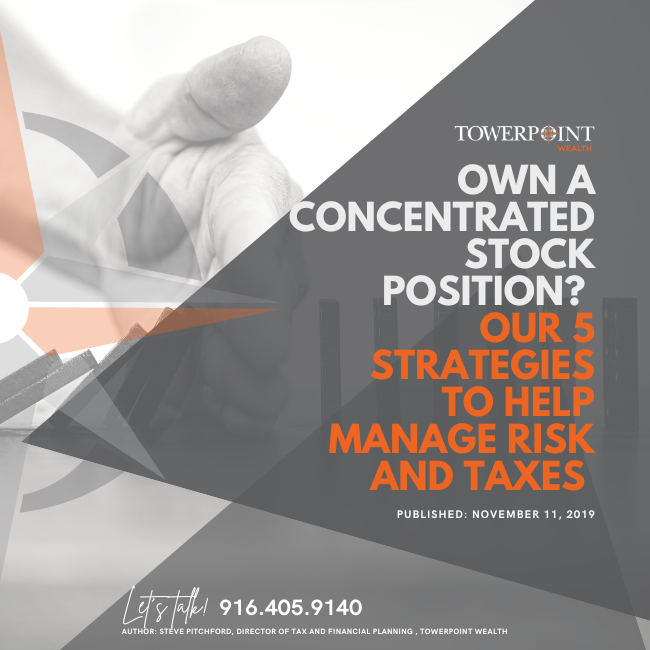
Own a Concentrated Stock Position? Our 5 Strategies to Help Manage Risk and Taxes
Stock compensation can be a wonderful complement to a traditional compensation package, oftentimes contributing significantly to an investor’s net worth. However, there is an overlying risk to investors who have too much of their net worth concentrated in the stock of one company. This is more complicated if this stock has appreciated to an extent that selling would result in a substantial capital gains tax liability.
How can an investor mitigate the risk of having too much of their net worth concentrated in a single appreciated stock, and avoid significant tax liabilities?
Multiyear-Sales Strategy
Some investors may feel that the solution to owning an overconcentration of stock in a single company is simple: sell all of the stock and reinvest the proceeds in a diversified portfolio. While this strategy has the obvious benefit of immediately eliminating the overconcentration risk, the tax “hit” of utilizing this strategy can be substantial – especially considering that investors who received the stock as compensation may have a very low (or no) cost basis in it.
One approach to mitigate the tax impact of these stock sales is to amortize them over a period of two or three years. While this will not reduce an investor’s risk exposure as quickly as an outright sale, this strategy has the advantage of spreading the capital gains taxes over a multiyear period – allowing an investor to better control the timing of the capital gains with the goal of realizing more of these gains in relatively low tax years.
Put Option or Protective Equity Collar
A put option gives an investor the right to sell a stock at an agreed upon price on or before a particular date. The advantage of owning a put option is that it establishes a “floor” price at which the investor will be able to sell a stock position. This greatly reduces an investor’s downside risk, while at the same time allows them to retain the unlimited upside.
Instead of paying “out-of-pocket” to cover the premium (cost) of the put option, an investor can simultaneously sell a call option, which gives the purchaser of the call option the right to buy the stock at an agreed upon price on or before a particular date.
The strategy of simultaneously buying a put option and selling a call option is known as a protective equity collar. The potential drawback of an equity collar is the investor is now limited on the upside of the stock price as well. However, understanding that the premium from selling a call option will often cover the entire premium to purchase the put option, an equity collar can be a low-cost approach to hedging a concentrated stock position. Buying and selling options is best handled by a financial professional working on your behalf.
Pool Shares into an Exchange Fund
Exchange funds are private placement partnerships where an investor contributes a concentrated stock position into a fund that includes a mix of other stock positions. Oftentimes, these other stocks were donated by investors that had the same intent of diversifying their own appreciated stock positions.
With exchange funds, each investor receives a pro-rata share of the partnership (measured in units) based on the value of the stock that they contributed.
While one obvious advantage of an exchange fund is immediate diversification, an additional appeal of this strategy is that capital gains taxes are deferred until the investor sells their fund units.
There are several important disadvantages of exchange funds, such as the typically high fund management fees, the lack of control over the other stock positions in the fund, and the lock-up period before an investor can sell their units (which is often as high as seven years). Further, exchange funds are regulated private placements, so they are typically subject to investment minimums and only available to investors that meet certain net worth thresholds.
Variable Prepaid Forward Contract
A Variable Prepaid Forward (VPF) contract is an agreement that an investor will sell a specific number of shares at a discount (usually between 75-90%) at a pre-specified future date in return for an upfront cash payment.
The “variable” in the term VPF refers to the fact that the shares the investor is selling at a future date are not fixed and are dependent on the performance of the stock. A lower stock price results in more shares sold to satisfy the obligation and a higher stock price results in fewer shares sold.
The benefit of a VPF contract is the immediate liquidity received from the cash advance. In addition, the use of the VPF contract allows for the deferral of capital gains – as the variability of the shares to be sold means that a VPF contract is not deemed a constructive sale by the IRS until the shares are delivered. However, in order to avoid IRS scrutiny, a VPF contract should be drafted by a qualified tax professional or lawyer.
Charitable Gifting
While charitable gifting is a broad category that requires further in-depth discussion, there are several charitable gifting strategies an investor can utilize to reduce the risk of an overconcentrated stock position.
The simplest strategy is for an investor to donate the overconcentrated stock position to a charity (or charities) of their choice. Not only will an investor generally receive the same exact
tax deduction as if they donated cash, donating stock has the dual benefit of eliminating the capital gains tax that would be associated with selling the stock outright.
In our view, donating stock is a great way for an investor to both reduce their concentrated stock position and fulfill their charitable intentions.
Pairing this with a Donor-Advised Fund (DAF), a charitable investment account, can streamline the process of gifting stock and has the added benefit of allowing an investor to control the timing of both their tax deductions and their donations.
There are also different charitable trusts that may be appropriate for an investor with an overconcentrated stock position. These types of trusts, which include a Charitable Remainder Trust (CRT) and Charitable Lead Trust (CLT), allow an investor to better control and customize the charitable strategy that works best for them.
Charitable trusts come with material costs and added complexity, and we recommend you work with an experienced estate planning attorney and your financial advisor to determine the best choice for you.
How Can We Help?
At Towerpoint Wealth, we are a fiduciary to you, and embrace the legal obligation we have to work 100% in your best interests. We are here to advise you, and will work with you to decide the optimal strategy for your concentrated stock position.
Search results for “wealth advisor near me” include the Towerpoint Wealth team because we’re in the middle of it all. Towerpoint Wealth is a fee-only certified financial planner near Roseville, Rocklin, Granite Bay, Folsom, Gold River, El Dorado Hills, East Sacramento, Curtis Park, Land Park, Elk Grove, and Rancho Murietta.
Are you searching “certified financial planner near me?” You’ve found Sacramento independent financial planner Joseph Eschleman, as well as certified financial planner Steve Pitchford, CPA, CFP®, our entire independent wealth management team. Please reach out to us to learn more about how our Sacramento financial planning team can assist you.






